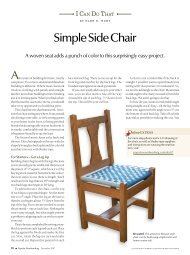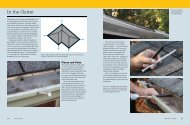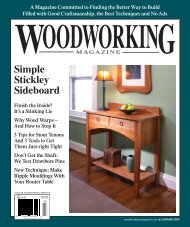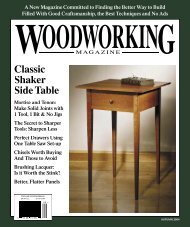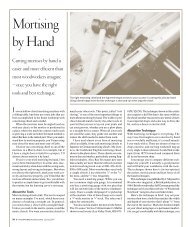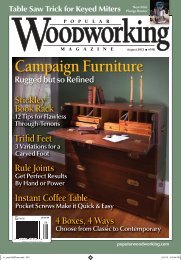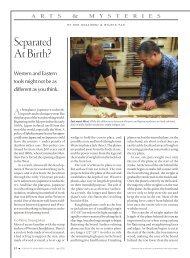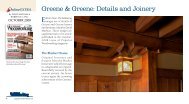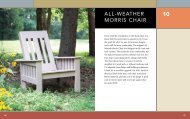Classic Shaker Side Table - Popular Woodworking Magazine
Classic Shaker Side Table - Popular Woodworking Magazine
Classic Shaker Side Table - Popular Woodworking Magazine
You also want an ePaper? Increase the reach of your titles
YUMPU automatically turns print PDFs into web optimized ePapers that Google loves.
3⁄8The 3 ⁄ 8 "-long tenons arecut using the same setupon your router table. Hereit’s obvious that tenons arenothing more than rabbetsthat have multiplied.A 5 ⁄ 8 "-wide chisel makes quick and accurate work of the small mortiseson the legs. If you don’t have a mortising chisel, a standard bevel-edgechisel will do the job, though you should avoid wailing on the handleand levering out the chips as much as possible. Work from the centerout as shown. Mark the mortise depth on your chisel using permanentmarker (believe me, it’s not permanent). This works better than tape.Shave 1 ⁄ 16 " of all four faces of the tenons for thelower front rail. Make the same cut on three facesof the upper front rail. Then raise the bit’s heightto almost 3 ⁄ 16 " and shave the two larger cheeks onthe lower rail. Adjust the height of the bit until thelower rail fits snugly into its mortise.Once you glue up the joint, the shoulder is supportedjust fine, but you risk breaking it beforeassembly time.So I opted for 3 ⁄ 8 "-long tenons. There is still aremarkable amount of gluing surface and the jointis more than stout enough for a table this small.When you make a bigger table in the future, youcan make bigger tenons.For details on executing this joint, see “Mortises& Tenons for <strong>Table</strong>s” on page 6.After milling the mortises and the tenons forthe aprons and the legs, you need to join the fronttwo legs with the front two rails. This is a fiddlybit of joinery, but there are some tricks to make itfoolproof. Let’s start with the lower front rail.The lower front rail needs to be mortised intothe front legs. The best way to cut the mortisesis with a chisel. First lay out the location of themortises on the front legs. The mating tenon onthe rail will be 3 ⁄ 8 " thick x 5 ⁄ 8 " wide x 3 ⁄ 4 " long.Next, lay out the mortise wall 1 ⁄ 4 " in from thefront edge of the legs.Chop out the mortises to a depth of 3 ⁄ 4 ". Workfrom the center to the ends of the mortise withthe bevel facing the center of the hole. Keep inmind as you work that though you want to be asneat as possible, the edge of the mortise will beconcealed by the shoulders of the tenon, so theoccasional small ding is no harm done.Now you can cut the corresponding tenon onthe lower front rail. Use the same procedure asyou did for the tenons on the aprons. First set theheight of the bit to 1 ⁄ 16 ". Then adjust the fence sothe tenon will be 3 ⁄ 4 " long. Make a couple of testcuts to confirm your setup.With the bit at this setting, cut away all fourfaces of the tenon on the lower rail. Next, get theupper front rail and make this cut on three facesand set it aside. Now increase the height of thebit and shave away material on the tenons untilthe lower rail fits in its mortise snugly.The upper front rail is dovetailed by hand intothe front legs. Before you despair, take a look atthe upper rail, which you just tenoned on threefaces. You’ve cut three perfect shoulders for thisjoint. So even if your dovetail is the sloppiest oneever cut (which is doubtful), it will still fit tightlyagainst the legs and the joint will never show.With that knowledge, lay out a 3 ⁄ 4 "-long dovetailon each end of the upper front rail. Its size andslope aren’t critical. Lay it out so it’s easy to cut andyet takes away as little material as possible. Andmake the slope of the angle about 8° or so.Simple <strong>Shaker</strong> End <strong>Table</strong>NO. PART SIZES (INCHES) MATERIAL NOTEST W LCut the dovetail on the end of the rail. Next,dry-assemble the table base and clamp up all thejoints. Place the upper rail in place (the shouldersshould fit tightly between the legs) and trace thedovetail shape onto the top of the front legs andthe part of the apron tenon that it overlaps. Disassemblethe table and saw out the socket in thelegs and on the top of the aprons’ tenons.Now you can assemble the table without glueand take a look at how your joints fit.Taper the LegsThere are a variety of ways to cut tapers on legs.I don’t like the commercial tapering jigs fortable saws. They work, but they put your hand tooclose to the blade. Shop-made tapering sleds are<strong>Table</strong>❑ 4 Legs 1 1 ⁄ 8 1 1 ⁄ 8 26 3 ⁄ 4 Cherry Taper to 5 ⁄ 8 "❑ 1 Top 3 ⁄ 4 18 18 Cherry 1 ⁄ 4 " x 2" bevel on underside❑ 3 Aprons 3 ⁄ 4 5 12 1 ⁄ 2 Cherry 3 ⁄ 8 " tenon both ends❑ 2 Front rails 3 ⁄ 43 ⁄ 4 13 1 ⁄ 4 Cherry 3 ⁄ 4 " tenon or dovetail❑ 4 Drawer guides 3 ⁄ 4 1 12 1 ⁄ 8 Cherry Notched around legs❑ 2 Spacers 3 ⁄ 163 ⁄ 4 11 3 ⁄ 4 Cherry Glued to apronsDrawer❑ 1 Front 3 ⁄ 4 3 1 ⁄ 2 11 3 ⁄ 4 Cherry 1 ⁄ 4 " x 1 ⁄ 2 " rabbet on ends❑ 2 <strong>Side</strong>s 1 ⁄ 2 3 1 ⁄ 2 12 1 ⁄ 4 Poplar❑ 1 Back 1 ⁄ 2 3 11 3 ⁄ 4 Poplar 1 ⁄ 4 " x 1 ⁄ 2 " rabbet on ends❑ 1 Bottom 1 ⁄ 2 11 1 ⁄ 4 12 3 ⁄ 8 Poplar In 1 ⁄ 4 " x 1 ⁄ 4 " groove18 ■ woodworking magazine Autumn 2004



